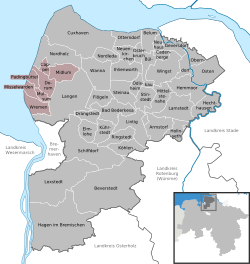Land Wursten
| Land Wursten | |||
|---|---|---|---|
|
|||
| Coordinates: 53°42′N 8°33′E / 53.700°N 8.550°ECoordinates: 53°42′N 8°33′E / 53.700°N 8.550°E | |||
| Country | Germany | ||
| State | Lower Saxony | ||
| District | Cuxhaven | ||
| • Mayor | (SPD) | ||
| Area | |||
| • Total | 116.97 km2 (45.16 sq mi) | ||
| Population (2013-12-31) | |||
| • Total | 9,551 | ||
| • Density | 82/km2 (210/sq mi) | ||
| Time zone | CET/CEST (UTC+1/+2) | ||
| Website | www.sglandwursten.de | ||
Land Wursten is a former Samtgemeinde ("collective municipality") in the district of Cuxhaven, in Lower Saxony, Germany. It was situated approximately 20 km (12 mi) southwest of Cuxhaven, and 15 km (9.3 mi) north of Bremerhaven. Its seat was in the village Dorum. It was disbanded in January 2015, when its member municipalities merged into the new municipality Wurster Nordseeküste.
The Samtgemeinde Land Wursten consisted of the following municipalities:
The Land of Wursten was a rather autonomous Frisian farmers' republic in Northern Germany under only loose overlordship of the Prince-Archbishopric of Bremen. Bremian knightly families aimed at subjecting the Wursten Frisians. The Lords of Diepholz owned the Hollburg Castle between Holßel and Midlum on the brink of the Wesermünde Geest ridge, allowing a good view over the lower Land of Wursten. In 1219 six Diepholz Lords, related as cousins, owning estates in and near Midlum, founded the Midlum Nunnery and endowed them to it. Rather than establishing the nunnery as their proprietary monastery the Diepholz family made it over to the cathedral chapter of the Bremen archdiocese. However, the Diepholz family adopted the advocacy (Vogtei) over the nunnery, later passed on to the Knights of Bederkesa who were related by marriage.
The convent's actual original affiliation to a monastic order is not documented. No hint is recorded that the convent strove to be incorporated into the Cistercian Order. It is also possible that the convent followed Cistercian customs without formal incorporation. However, the convent started the typical Cistercian practice to build up a large autark integrated production (Eigenwirtschaft). Unlike unsettled and undeveloped areas where Cistercians usually founded new monasteries the farmlands donated to the convent were held by feudal tenants and sparsed in and around Midlum. The convent cleared its feudal farmlands from the unfree peasants tilling them (cf. Lowland Clearances) transforming them into dependent agrarian workers or cotters (smallholders who need additional work) and (most of) their fields into the convent's demesne.
...
Wikipedia




